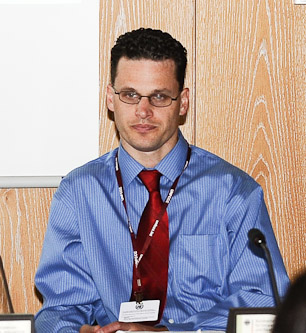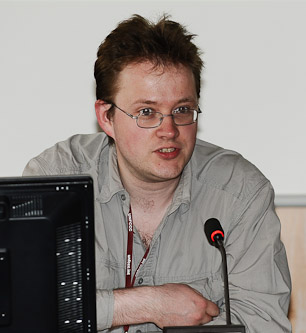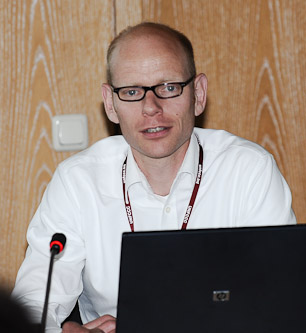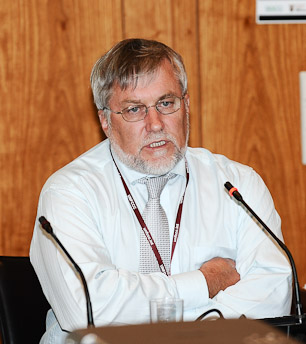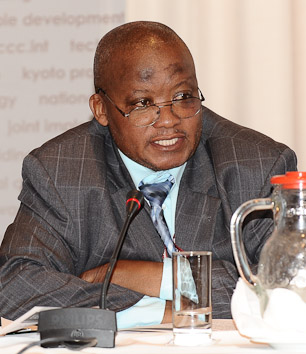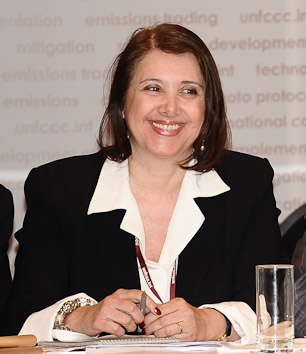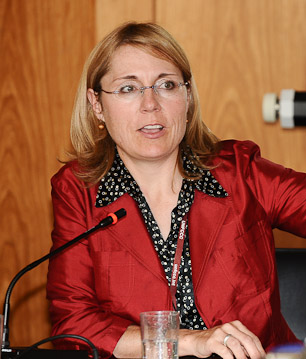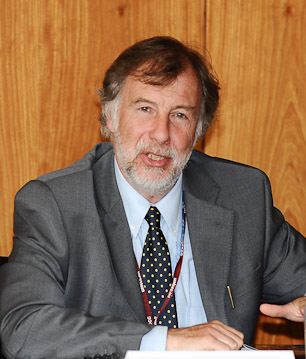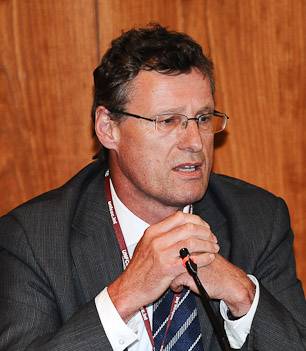 |
A Special Report on Selected Side Events at the 1-12 June 2009 Bonn, Germany |
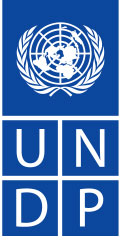 |
| Daily Web Coverage and Reports | ||||||||||||||||||||||||
| 1 June | 2 June | 3 June | 4 June | 5 June | 6 June | 8 June | 9 June | 10 June | 11 June | 12 June | ||||||||||||||
| HTML | ||||||||||||||||||||||||
Events on Tuesday, 2 June 2009
Towards an Effective and Equitable Post-2012 Regime
Presented by Wuppertal Institute for Climate, Environment and Energy
This event presented the Wuppertal Institute’s comprehensive proposal to stabilize global temperature increases below 2°C by ensuring that global GHG emissions decrease by at least 80% of 1990 levels by 2050.
Wolfgang Sterk, Wuppertal Institute, summarized key elements of the Wuppertal proposal, including that: emissions should peak this decade in Annex I and non-Annex I countries and that the latter will require significant Annex I support; Annex I parties should assume both new and stringent emission reduction targets and legally-binding obligations to provide financial and technological support; in the mid-term, rather than using the current Annexes, a principle-based approach that assigns countries targets based on their evolving responsibilities and capabilities should be adopted; and all parties except Least Developed Countries and Small Island Developing States should develop low-emission development plans.
Sterk said financing for the proposal should come from a fund-based mechanism sourced from the sale of Assigned Amount Units (AAUs) and from a new mechanism covering emissions from maritime and aviation sectors. He explained that the fund should be distributed not according to cost assessments and additionality of “actions,” but on a “country basis” according to criteria for responsibility, capability and vulnerability to climate change impacts. He clarified that differentiated responsibilities under the Wuppertal proposal would initially be based on the Greenhouse Development Rights framework.
Niklas Höhne, Ecofys, critiqued the Wuppertal proposal for not offering: justification for the proposed policy choices, such as a midterm target of 60% emission reductions below 1990 levels for Annex I countries; an explanation of how the proposal would improve the chances of reaching agreement in Copenhagen; quantifiable estimates of required financial support; or a rationale for an alternative classification of countries. On finance, he said market mechanisms should not be dismissed and questioned the political feasibility of “country-based” rather than “action-based” funding.
Jake Schmidt, National Resources Defense Council, noted that modest policies usually lead to more ambitious ones, and recommended: shifting the emphasis from single-year targets to cumulative emissions; emphasizing commitments to actions rather than results; international registration and verification of domestic actions in developing countries; making funding conditional on effective action; combining public and private funding mechanisms; and developing a strong forestry strategy.
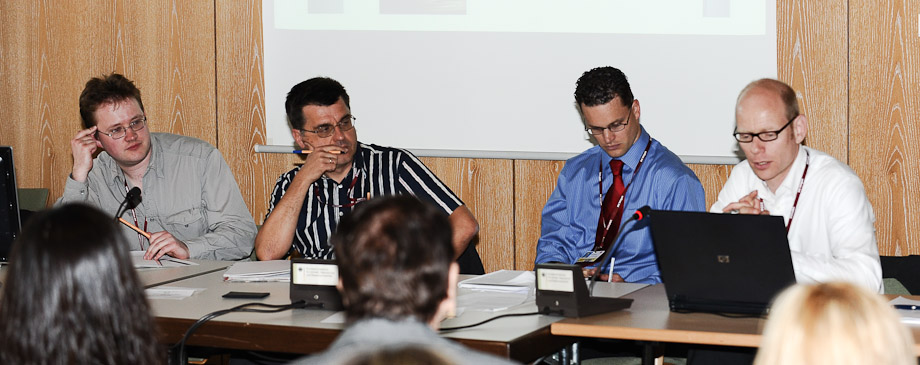 |
| L-R: Wolfgang Sterk, Wuppertal Institute; Richard Brand (Coordinator), Church Development Service (EED); Jake Schmidt, Natural Resources Defense Council; and Niklas Höhne, Ecofys |
|
|
Adaptation – The Role of Biodiversity
Presented by the Secretariat of the Convention on Biological Diversity
This panel discussed the work of the Convention on Biological Diversity's Ad Hoc Technical Expert Group (ADTEG) on Biodiversity and Climate Change, with a focus on ecosystem-based adaptation.
Guy Midgley, South African National Biodiversity Institute, introduced the AHTEG report, noting that linkages between biodiversity and climate change are complex and the adverse effects of climate change on biodiversity are already observable and attributable. He noted several conservation responses, including maintaining intact and interconnected ecosystems to increase resilience and allowing biodiversity and people to adjust to changing conditions.
Ian Noble, World Bank, explained that ecosystem-based adaptation is the use of sustainable ecosystem management to support societal adaptation. He emphasized that ecosystem-based adaptation must be integrated into an overall sustainable development strategy, highlighting that it brings various social and economic co-benefits, including products derived from forest retention. He added that ecosystem-based adaptation can also contribute to mitigation through maintenance of carbon stocks.
Trevor Sandwith, The Nature Conservancy (TNC), discussed the results of various ecosystem-based adaptation case studies in tropical seas. He stressed the importance of considering both ecological and societal impacts of climate change and adaptation measures. Highlighting that consideration of people raises important issues related to tenure, rights, responsibilities and good governance, he emphasized the importance of mobilizing local community involvement in adaptive responses.
Participants discussed the utility of ecosystem-based adaptation given its complexity and the linkages between community- and ecosystem-based adaptation. They highlighted the need to: share experiences; be cautious about embracing specific terminology in UNFCCC negotiations before there is shared understanding about what different terms mean; translate the ideas to non-specialists; and develop simple principles to underlie the concept of ecosystem-based adaptation.
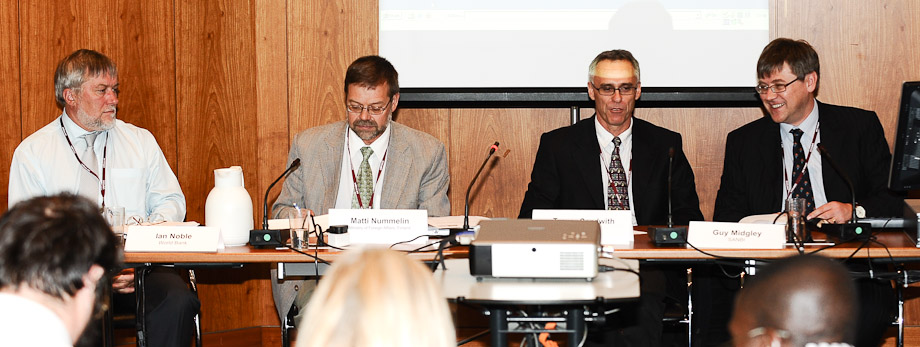 |
| L-R: Ian Noble, World Bank; Matti Nummelin, Finland; Trevor Sandwith, TNC; and Guy Midgley, South African National Biodiversity Institute |
|
|
Least Developed Countries Expert Group (LEG)/ Least Developed Country (LDC) Update on NAPA
Presented by the UNFCCC Secretariat
Paul Desanker on behalf of Preety Bhandari, UNFCCC Secretariat, said the UNFCCC fully supports the work of the LEG, whose progress was discussed at this event.
Bruno Sekoli, LDC Group Chair, noted that 41 LDCs have submitted National Adaptation Programmes of Action (NAPAs), in which they identified 437 urgent projects for climate change adaptation, but that the Global Environment Facility (GEF) has yet to dispense funds to implement any of them.
Fred Onduri Machulu, LEG Chair, said the LEG has created a draft technical paper to help LDCs update their NAPAs and will develop a step-by-step guide on NAPA implementation. He noted that LDCs need guidance on selecting GEF implementing agencies with comparative advantages in sectors most relevant to their countries' needs.
Bonizella Biagini, GEF Secretariat, explained that financing from the LDC Fund (LDCF) is intended to supplement expenditures that LDCs would already spend on “business-as-usual” development projects. She clarified that under the LDCF, “co-financing” refers to LDCs’ “business-as-usual” expenditures, while the LDCF would cover the additional costs of the project that are related to adaptation needs.
Anwar Noaman, Yemen, described an integrated coastal zone management project that his country identified in its NAPA and hopes to implement in partnership with the World Bank, starting in September 2010. Syamphone Sengchandala, Lao People’s Democratic Republic, identified barriers to NAPA implementation, namely: lack of coordination and cooperation among sectors; weak institutional arrangements; and limited available financing.
Providing examples of location-specific adaptation practices, Michael Mutale, independent water expert, Zambia, stressed that communities know how to promote adaptation but need formal consultation and other mechanisms to do so.
Parties discussed, inter alia, whether NAPA updates would further delay implementation.
|
|
In Search of Shelter: Mapping the Effects of Climate Change on Human Migration
Presented by United Nations University
Charles Ehrhart, CARE International, and Koko Warner, United Nations University (UNU), opened the event by summarizing the findings of a report entititled "In Search of Shelter: Mapping the Effects of Climate Change on Human Migration and Displacement.
Stressing the unique empirical contribution of the report, Warner explained that the study examined 24 case studies, developed eight new maps and conducted interviews with 1000 migrants and nearly as many non-migrants who face environmental stressors. She highlighted the report’s finding that environmental stressors are a factor driving migration.
Ehrhart explained that the ecosystem degradation effects of climate change undermine the livelihoods of some of the world’s poorest people. He lamented the lack of attention paid to the potential loss of agricultural land due to sea level rise. Warner added that sea level rise has the potential to submerge or partially submerge the territory of over 40 sovereign states.
Jean-François Durieux, UN High Commissioner for Refugees (UNHCR), stressed the report’s contribution to building empirical evidence rather than unfounded “doomsday scenarios.” He highlighted key challenges to addressing migration issues, including avoiding the erosion of social fabric and maintaining the link between individual migrants and the state.
Julia Martinez, Mexico, discussed factors resulting in climate-induced migration in Mexico, including high rates of evapotranspiration and flooding in some regions.
Mizan Khan, North South University, Bangladesh, discussed climate-induced migration in his country. He emphasized that internal migration is a considerable problem and that internal adaptation measures are needed.
Participants discussed, inter alia: the impacts of forced migration on the poor, who are least able to pay for migration; the difficulty in distinguishing voluntary from forced migration; the forthcoming UNDP report on migration; the “securitization” of migration; and how to incorporate migration into UNFCCC negotiations.
 |
L-R: Julia Martínez, Mexico; Jean-François Durieux, UNHCR; Mizan Khan, North-South University, Bangladesh; Koko Warner, UNU; and Charles Ehrhart, CARE International |
|
|
Presented by Greenpeace International
The event addressed how to incorporate biodiversity considerations into REDD mechanisms.
Janet Cotter, Greenpeace, said no amount of money can compensate for biodiversity loss. She noted that the loss of Amazon rainforests would affect rainfall patterns in the US’ agricultural Midwest.
Horst Freiberg, Germany, presented findings of the CBD AHTEG expert group on Biodiversity and Climate Change. He stated that: REDD methodologies should consider gross deforestation rates; co-benefits for biodiversity can be achieved by REDD activities in forest areas with high carbon stocks; and adaptation policies should aim to enhance the natural adaptive capacity of species.
Till Pistorius, Institute of Forest and Environmental Policy, said REDD can create direct risks for biodiversity through transformation of natural forests to plantations and the prioritization of “high carbon” forests at the expense of other types. He called for: prioritizing natural forests in REDD activities; excluding plantations from forest definitions; and establishing “tropical target benchmarks” against which to measure country performance.
Christoph Thies, Greenpeace, said the goal for the next ten years should be to provide incentives for dramatic reduction of deforestation and creation of new protected forests, while in the long-run REDD should be expanded to include ecological restoration of lost or degraded forests. Thies stressed the importance of agreeing on a REDD mechanism that simultaneously leads to reduced emissions, reduced deforestation and biodiversity protection.
Participants discussed: the importance of clear definitions of forest types; the difference between gross deforestation and net deforestation; and the decreasing emphasis on conservation in REDD discussions.
 |
| L-R: Janet Cotter, Greenpeace; Horst Freiberg, Germany; Till Pistorius, Institute of Forest and Environmental Policy; and Christoph Thies, Greenpeace |
|
|
| Daily Web Coverage and Reports | ||||||||||||||||||||||||
| 1 June | 2 June | 3 June | 4 June | 5 June | 6 June | 8 June | 9 June | 10 June | 11 June | 12 June | ||||||||||||||
| HTML | ||||||||||||||||||||||||
Digimarc and the Digimarc logo are registered trademarks of Digimarc Corporation. The "Digimarc Digital Watermarking" Web Button is a trademark of Digimarc Corporation, used with permission.
Please e-mail the Digital Editor should you have any questions regarding the content of this page.
| Back to IISD RS "Linkages" home | Visit IISDnet | Send e-mail to ENB |
© 2009, IISD. All rights reserved.

